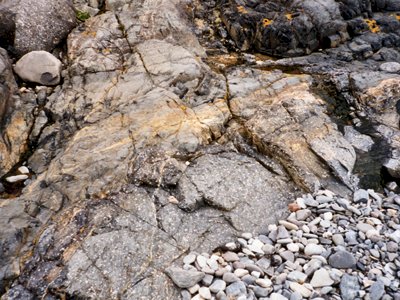Earth Science Conservation Review
| Mournes - Green Harbour Dyke No. 55 | Down |

| Site Type: | Coastal section |
| Site Status: | ASSI |
| Council area: | Newry & Mourne District Council |
| Grid Reference: | J388248 |
| Google maps: | 54.15393,-5.87542 |
| Rocks | |
|---|---|
| Rock Age: | Tertiary (Eocene) |
| Rock Name: | Granite |
| Rock Type: | Dolerite, Variolite |
| Interest | |
| Other interest: | amygdales, dyke, Intrusion |
Summary of site:
For an explanation of the numbering of the coastal dykes around the Mourne Mountains see site 1109.
This dyke at Green Harbour shows at least three phases of intrusion by molten magmas. The first formed a rock of basaltic composition which cooled relatively slowly to form an olivine dolerite, a rock of medium grain size. It varies in width from 3 to 8 m. The original rock has been somewhat altered and shows interesting mineral structures. Chilled against it is an almost glassy rock, called variolite, with fine, needle-like crystals in radiating masses which contains many trapped bubbles, now mineral-filled, up to 4 cm in length. Quartz and alkali-feldspar are identifiable, encrusting the walls of the vesicles and some are filled with hornblende. Thomson, the Scottish geochemist, analysed hornblende from here in 1836 and named it kirwanite (after Richard Kirwan, the famous Irish chemist) in the mistaken belief that he had found a new mineral. This intrusion is 3 m thick.
Cutting across both these early phases of the dyke is a second variolite with larger crystals of a chemistry alien to the rock, which is andesite, intermediate in character (between granite and basalt). The alien crystals (xenocrysts) are mostly quartz and alkali feldspar and must have been derived from a melt of granitic composition, presumably at considerable depth. This, the last intrusion here, is again 3 m thick.
Some time after cooling and solidification these intrusions were faulted by the release of local stress along the line of a crush zone and their alignment was offset.
These rocks are believed to have been derived from a deep-seated, primitive, unrefined magma that slowly stabilized during crystallization to create the later, somewhat lighter, variolites. The presence of vesicular gas bubbles suggests lower pressures allowing volatiles to become gases as the magma neared the earth's surface.
The best exposure of these typical Mourne dyke rocks is at the top of the beach just below the high water mark.
This dyke at Green Harbour shows at least three phases of intrusion by molten magmas. The first formed a rock of basaltic composition which cooled relatively slowly to form an olivine dolerite, a rock of medium grain size. It varies in width from 3 to 8 m. The original rock has been somewhat altered and shows interesting mineral structures. Chilled against it is an almost glassy rock, called variolite, with fine, needle-like crystals in radiating masses which contains many trapped bubbles, now mineral-filled, up to 4 cm in length. Quartz and alkali-feldspar are identifiable, encrusting the walls of the vesicles and some are filled with hornblende. Thomson, the Scottish geochemist, analysed hornblende from here in 1836 and named it kirwanite (after Richard Kirwan, the famous Irish chemist) in the mistaken belief that he had found a new mineral. This intrusion is 3 m thick.
Cutting across both these early phases of the dyke is a second variolite with larger crystals of a chemistry alien to the rock, which is andesite, intermediate in character (between granite and basalt). The alien crystals (xenocrysts) are mostly quartz and alkali feldspar and must have been derived from a melt of granitic composition, presumably at considerable depth. This, the last intrusion here, is again 3 m thick.
Some time after cooling and solidification these intrusions were faulted by the release of local stress along the line of a crush zone and their alignment was offset.
These rocks are believed to have been derived from a deep-seated, primitive, unrefined magma that slowly stabilized during crystallization to create the later, somewhat lighter, variolites. The presence of vesicular gas bubbles suggests lower pressures allowing volatiles to become gases as the magma neared the earth's surface.
The best exposure of these typical Mourne dyke rocks is at the top of the beach just below the high water mark.
| Enlander, I., Dempster, M. & Doughty, P., 2025. Mournes - Green Harbour Dyke No. 55, County Down, site summary. [In] Earth Science Conservation Review. https://www.habitas.org.uk/escr/summary.php?item=1112. Accessed on 2025-04-03 |
| Previous Site | Next Site |

